SpaceX Crew Dragon Test Flight Ends With Spot-On Splashdown
The first test flight of SpaceX's Crew Dragon appears to have been an all-around success.
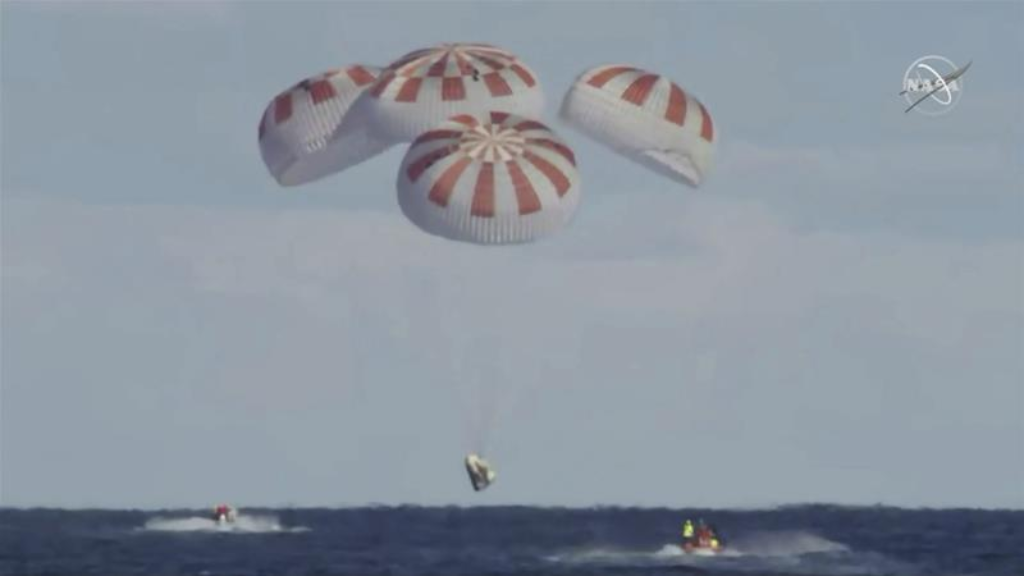
Earlier today, SpaceX’s Crew Dragon successfully completed its first test flight to the International Space Station with a successful splashdown in the Atlantic Ocean:
The new American spacecraft capable of carrying astronauts and built by SpaceX gently splashed down in the Atlantic Ocean on Friday morning, ending a successful demonstration trip.
“This is an amazing achievement in American history,” Jim Bridenstine, the NASA administrator, said on NASA Television afterward.
The mission, even though there were no astronauts aboard, was a milestone in NASA’s strategy of turning to private companies to provide trips to orbit for its astronauts. Instead of building its own vehicles, like the space shuttles that were retired in 2011, the space agency hired SpaceX and Boeing to develop commercial space systems.
Last Saturday, SpaceX was the first to launch its spacecraft, an upgraded version of the Dragon capsule that has carried cargo to the space station for years. The Crew Dragon capsule docked with the International Space Station a day later. Early on Friday, it left and after a couple of orbits of Earth, it fired its thrusters to allow Earth’s gravity to pull it down.
Mr. Bridenstine praised not only SpaceX and NASA but also earlier presidential administrations. More than a decade ago, NASA under the George W. Bush awarded the first contracts for companies to take cargo to the International Space Station. The Obama administration expanded that to include astronauts.
“We’re going to have numerous providers that are going to compete on cost and innovation,” Mr. Bridenstine said.
The Crew Dragon capsule landed right on schedule, at 8:45 a.m. Eastern time about 230 miles off the east coast of Florida.
“If you missed it, I’m sorry, because that was really cool to see,” Daniel Huot, a NASA spokesman, said on NASA Television.
Even though there were no people aboard, there was a spacesuit-adorned mannequin, nicknamed Ripley after the heroine in the “Alien” movies, sitting in one of the Crew Dragon seats. The mannequin’s sensors will tell engineers how the trip would have been for humans.
The capsule was fished out of the ocean, covered in scorch marks from the atmospheric re-entry that made it look like a toasted marshmallow.Once brought back to shore, the same capsule will be refurbished for another launch, also uncrewed, as soon as June. That trip will be more harrowing — a simulated malfunction of the rocket. The spacecraft’s thrusters will attempt to whisk away the capsule, which will then parachute into the ocean.
If that works, two NASA astronauts will ride in another Crew Dragon capsule to the International Space Station, perhaps as soon as July.
Boeing’s first crewless test of its Starliner capsule is scheduled for the end of April, and its first flight with astronauts could occur later this year.
“These are all capabilities that are leading to a day when we are launching American astronauts on American rockets from American soil,” Mr. Bridenstine said.
More from The Washington Post:
SpaceX’s Dragon spacecraft splashed down safely in the Atlantic Friday after undocking from the International Space Station, appearing to successfully complete the first mission of the vehicle the company designed to fly humans.
There were no people on board the spacecraft, built to carry four NASA astronauts to the International Space Station. The nearly week-long journey culminated when the spacecraft disembarked from the station about 2:30 a.m. Friday, fired its engine to slow down, and barreled through the thickening atmosphere on its fiery return to Earth until finally splashing down into the Atlantic Ocean at 8:45 a.m.
The capsule was hoisted out of the water and placed on the deck of a recovery boat shortly before 10 a.m.
The mission comes at a precarious time for brash billionaire Elon Musk, SpaceX’s founder and CEO, who has come under fire for his sometimes erratic behavior.
The reentry is one of the biggest tests of the Dragon and of SpaceX, the company founded by Musk in 2002 with the ultimate goal of flying humans to Earth’s orbit and beyond. If deemed a complete success, the mission would give NASA increased confidence in one of its prime contractors and propel the space agency a step closer to restoring human spaceflight from U.S. soil.
Since the space shuttle was retired in 2011, NASA has been unable to fly its astronauts. Instead, it has paid Russia for rides to the space station at an increasing price tag that now tops $80 million.
In 2014, NASA awarded contracts worth a combined $6.8 billion to SpaceX and Boeing to build spacecrafts capable of carrying NASA’s astronauts to the orbiting laboratory 250 miles above Earth. Since then, both companies have faced delays and setbacks. But now, SpaceX has taken a major leap forward and is poised to fly its first test mission with two NASA astronauts on board later this year.
Boeing is scheduled to fly its first uncrewed mission to the station by next month at the earliest, though that date is likely to slip, officials have said.
SpaceX’s uncrewed mission began early Saturday, when its Falcon 9 rocket blasted off in the predawn darkness from a historic launchpad at the Kennedy Space Center in Florida, where the crew of Apollo 11 began their journey to the lunar surface.
Once aloft, the SpaceX craft traveled to the space station, whizzing around Earth at 17,500 mph, catching up early the next morning. Before the mission, NASA officials had said the spacecraft’s ability to dock autonomously to the station would be one of the biggest tests of the vehicle.
Russia, one of NASA’s key partners on the space station, initially objected, citing concerns with SpaceX’s computer systems that would fly the vehicle toward the station.
But like the launch, the docking was a success, and soon the three astronauts on board the station — NASA’s Anne McClain, Oleg Kononenko of Russia, and Canada’s David Saint-Jacques — were able to check out the first commercial space vehicle designed for human space flight ever to dock with the station.
In a call with the astronauts on board the station Wednesday, Vice President Pence said, “It was inspiring to see the launch, and it was actually more inspiring to see the docking, and to see you all open that door and float into that spacecraft knowing that we’ll very soon have American astronauts arriving at the International Space Station in the same vehicle.”
The successful landing is a coup for SpaceX and a relief for Musk, who said he wouldn’t be able to relax until the spacecraft had landed safely.
While it’s difficult to tell from just observation, it does appear that this crucial test for the Crew Dragon was a success all around. The launch itself went off without a hitch, as did the docking and undocking with the International Space Station, and the return to Earth put the capsule down right in the range of where the planning wanted it to land. It’s possible, of course, that the underlying data will reveal some issues that engineers will have to deal with prior to the next test and, of course, prior to the first manned mission to the International Space Station, which is currently scheduled for July of this year. On the whole, though, the entire mission appears to have gone as well for SpaceX and NASA as they could have asked. Getting things ready for a crewed test and then regular use will take some time, but if all goes as planned we’ll finally have a way to get astronauts to the ISS without having to rely on and pay, the Russians for the privilege.
Congratulations to Elon Musk and the entire team at SpaceX!
Here’s the video of the coverage of the undocking and splashdown:

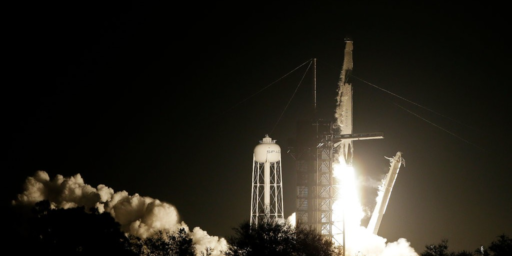
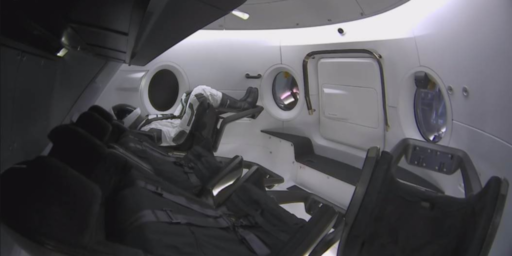
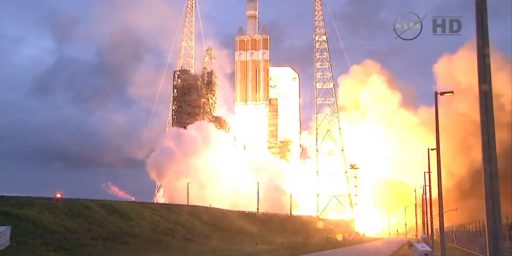
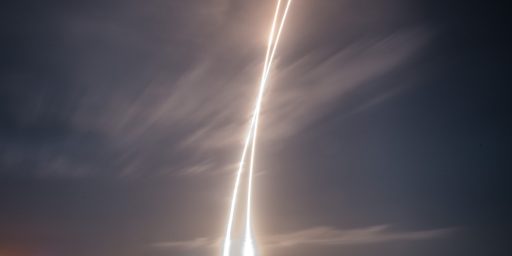
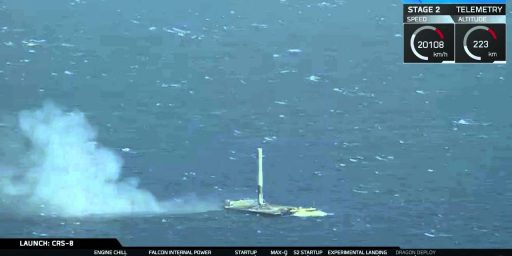
Maybe Elon Musk can build a wall???
I’m a little, tiny bit disappointed. I thought for sure Musk would go for something odd, unconventional, and way cool, like landing the capsule with rockets, or maybe a paraglider wing kind of parachute 😉
Seriously, this is the day when space travel ceased to be a government monopoly.
Ok. That’s not quite “One small step…” but nothing is.
In a way, NASA took a wrong turn going forward with the Shuttle (not entirely their fault), while the Soviets/Russians stalled in place, and now we’re redeveloping human space travel again.
Here’s hoping we’ll see much the same thing with Boom and supersonic passenger travel.
Here’s a bonus question…
Can anybody tell me who it was who said this would never happen because it was too expensive for a private concern to do it?
@Eric Florack: I have a different question: why do I care who said it? People have been mistaken on what the private sector can do lots of times. Sometimes, people have even said the private sector could do something only to be proven wrong when the private sector was either unable or unwilling to.
@Just nutha ignint cracker:
Well, there can be insights in what Clarke called “failure of imagination” regarding technological developments.
For instance, also from Clarke, two reactions to the telephone in its very early days:
1) The Americans may have a need of the telephone, but we do not. We’ve got plenty of messenger boys.
2) This is a most amazing invention! I can see the day when every city will have one.
I forget the sources, other than the first if from a British official.
Anyway, they were both wrong, but the second person was far less wrong.
@Eric Florack: A large amount of the development cash flow was early payments by the federal government for services to be delivered later. If it had been a flop, the feds would have been paying double for a lot of launches. Kudos to Musk and all of the SpaceX people, certainly, but it wouldn’t have happened without a big pile of government money. The rate of progress of the other private companies is pretty much directly proportional to how much federal money they’ve been able to get.
The daily show remembers Obama’s tan suit, the worst presidential scandal in US history.
@Michael Cain: wikitribune.com:
It’s not clear to me why the SpaceX Dragon is considered privately built, but the Chrysler Mercury-Redstone, the Convair Mercury-Atlas, the Martin Gemini-Titan II, the Chrysler/Douglas Saturn 1B, the Boeing/North American/Douglas Saturn V, and the United Space Alliance Space Transportation System are not.
@Stormy Dragon: off the top of your head, can you name the CEOs of any of those companies? Me neither. That’s a big part of why.
Elon was a world-class engineer, and a workaholic, but, reading about the early history of PayPal, it was his knack for marketing that made them successful.
@Stormy Dragon: Redstone, Atlas, and Titan were originally ICBMS, designed and built by the US government, and … uhh … not really intended for boosting people or other things into orbit. Saturn 1 and 5 were intended for spaceflight; they were designed and built by Werner von Braun and his crew at the US Army’s Redstone Arsenal in Hunstville, Alabama, not by commercial firms. ULA is a Lockheed-Boeing consortium launching evolved Atlas and Delta boosters, with a lot of help from DoD back in the 1980s.
Does that look like the wonderful free enterprise economic system to you?
Public-sector and private-sector is all mixed together in that stuff. I’m not a rocket aficionado, so I don’t know enough to comment on this specific item, but I was jogging and listening to a podcast a few months ago about Burt rutan and Virgin galactic etc, and they said that some aspects of the design of the latest SpaceX engines can be traced back to like Caltech in the 1950s or something.
@mike shupp:
Really? Where? There were no factories at the Redstone Arsenal after the Huntsville Arsenal was closed July 30, 1949. Did von Braun make them by hand in his garage on the weekends? When people say they ” built” things there, what they really mean is they oversaw programs funding private corporations to build things.
Take the Saturn V for example: The first stage was built by Boeing at the Michoud Assembly Facility in New Orleans. The second stage was built by North American Aviation in Seal Beach, California. The third stage was built by Douglas Aircraft Company in Huntington Beach, California. All the rocket engines were made by Rocketdyne at Canoga Park in Los Angeles. The Instrument Unit was made by IBM in Huntsville, Alabama. The Command and Service Modules were built by North American Aviation in Downey, California, and the Lunar Module was built by Grumman Aircraft in Bethspage, NY.
It’s not clear why the government paying SpaceX to make rockets is private, but all the previous government financed rockets are not.
@Teve: You mean that, yet again, Eric Florack is totally wrong about something? I don’t know about you, but I’m shocked…
There’s no end to Republican sleaze and amorality.
@An Interested Party: Republican propaganda pushes a few simple-minded assertions that don’t match up with reality. It makes their supporters easy punching bags.
@Eric Florack: You do realize that space X relies HEAVILY on NASA directly right? Especially when their rockets were exploding and they needed help trouble shooting. Space X also hired quite a few former NASA employees. Space X also relies heavily on tech developed by… .NASA……
@Stormy Dragon: Okay, I bow to your erudition. You’re better informed about this stuff than I had imagined — and I apologize for the condescending tone. Nonetheless, I will cling to the assertion that von Braun and his people designed the Saturn 5.
As for WHY the government treats SpaceX (and Orbital ATK, now part of Northrop Grumman) differently from other launch companies, the official notion is that SpaceX paid out of its own pocket (or the pocket of Elon Musk and his friends) for half or more of their rockets’ development costs, and thus is free to market launch services to anyone it wants (with some national security exceptions) as well as NASA.
Likely there’s some unofficial ideological stuff in the background, at least in some minds. Privatizing government-run programs was much praised at the White House level during the Clinton presidency, and commercial launch companies got a fair amount of attention, especially while the space shuttle program was on hold after Challenger. And of course, Republican like to show they love Free Enterprise a bunch, so when the Bush administration was looking for a shuttle replacement program after Columbia, taking the project away from NASA and giving it to a pair of commercial firms must have looked pretty good. (My take on this is that they lucked out with Musk; Orbital’s performance hasn’t been so illustrious, but is probably what one should have expected.) And since Bush had said so much nice about Free Enterprise and the
Commercial Cargo Program, it was just inevitable that Barak Obama and his people would double down with a Commercial Crew program. What could be more bipartisan?
Let’s see ..
https://bgr.com/2015/12/03/neil-degrasse-tyson-interview-space-exploration/
The implications, I’m sure, will be lost on The Usual suspects in here
Pretty much all launch vehicles, including the Shuttle, satellites, spacecraft, and probes, have been built by private industry under government contracts. NASA and/or the military often contribute to the design, and always set the specifications. NASA has rocket assembly facilities, where they put together components made by others, it has little in the way of manufacturing facilities, This si true of all government agencies. The Army doesn’t build tanks, the Air Force doesn’t build airplanes, and the Navy doesn’t build ships.
Now, all these things NASA commissioned were used and operated by NASA. Boeing, Grumman, Chrysler, Rockwell, Convair, etc. didn’t launch satellites or send missions to the Moon SpaceX, in contrast, operates the Falcon rockets itself, mostly at NASA facilities, from construction to launch, even for NASA payloads. That’s the big difference.
Of course, these days there are other companies going that route the United Launch Alliance operates its rockets and contracts launches with customers and NASA. Boeing is building its own space capsule, the Starliner.
@Kathy:
Quite true.
to the rest, the point I’m making here is even the level of governmental involvement that we currently have is too much. It is in fact holding back our progress as government does with everything. And that’s one of the implications I was making with the quote I posted.
private Enterprise left to its own devices on a problem will work out that problem far faster than anything the government can do alone or in concert with private business. It’s interesting how the supposed smartest guys in the room like Tyson for example are constantly extolling the virtues of government control over everything , and you have situations like this come along and they suddenly disappear from the scene. The fact is, turning such things as the exploration of space over to private Enterprise at the outset, would have tennis much further down the road.
By extension, then, the other implication of course is the Tyson isn’t as smart as he likes to pass himself off as being… Nor are the remaining smartest guys in the room.
@Matt: I’m aware of that NASA being the government agency like all government agencies intrudes where they don’t belong.
Usual suspects try to pass this off as we wouldn’t be able to get it done without government involvement. I suggest you that we get it done despite government involvement.
Prove me wrong
I’ll wait
The onus is on you to prove that statement to be correct…
@Eric Florack: Space X is the one who keeps running to NASA to get fixes/help… God damned you’re dense.
@An Interested Party: the problem is that the test that can’t be done because once government gets its hands on something it’ll never let go. Which is precisely why the founders decided limited government was the path.
Let’s look at the great inventions in our history. The automobile? Was Henry Ford granted government funds to do his research?
The airplane. Were the Wright brothers paid by the government?
Same question about Edison and the light bulb and however many other inventions he came up with. (I actually used to know the number as a bit of trivia)
Learn this if nothing else government cannot create. It can only regulate what others create in other words, all I can do is slow down development.
On the other hand look at what happens to our economy one government shrinks. Innovation increases wages go up places come down, etc.
and finally, I recognize I’m asking you to prove a negative, but you’re doing that with me as well. So let’s try it this way. Can you prove that our space exploration wouldn’t be well ahead of where we are now if government hadn’t taken it over, particularly given the history of what happens when government gets out of the way as noted above….
Oh…in other words, you can’t prove that your previous statement is correct…thanks for sharing…
Really? I had no idea that the Internet, the Tennessee Valley Authority, and the highway system in this country, among many other things, were created by the private sector…
Oh, I can beat that…without the government, there would be no space exploration…
@An Interested Party: imagine how much more successful all those WW2 vets would have been without the Montgomery GI Bill holding them back!
it’s ironic that he’s typing that on a computer that only functions because of integrated circuits, a technology that in the beginning was nurtured and funded for years by the federal government.
And then he transmitted those thoughts to us via the Internet. Thanks, DARPA!
Tomorrow when I do another 5k I’ll know I went 3.11 miles because my phone’s tracking GPS. Thanks DoD and Al Gore! (Not kidding. Look it up).
and the whole time I’m jogging I won’t have to worry about a run on the bank my money is kept in. Thanks FDIC!
Elon Musk is a shitheal dick and Space X is super cool He’s not yet Werner Von Braun compromised, but Musk is a goner to me in that I have zero trust in him.
I would not mind if Tesla was long-term successful and Space X too, but Musk as a powerful person is deeply troubling. I trust him not one bit, not one iota, not one jot, nor one other thingy as well.